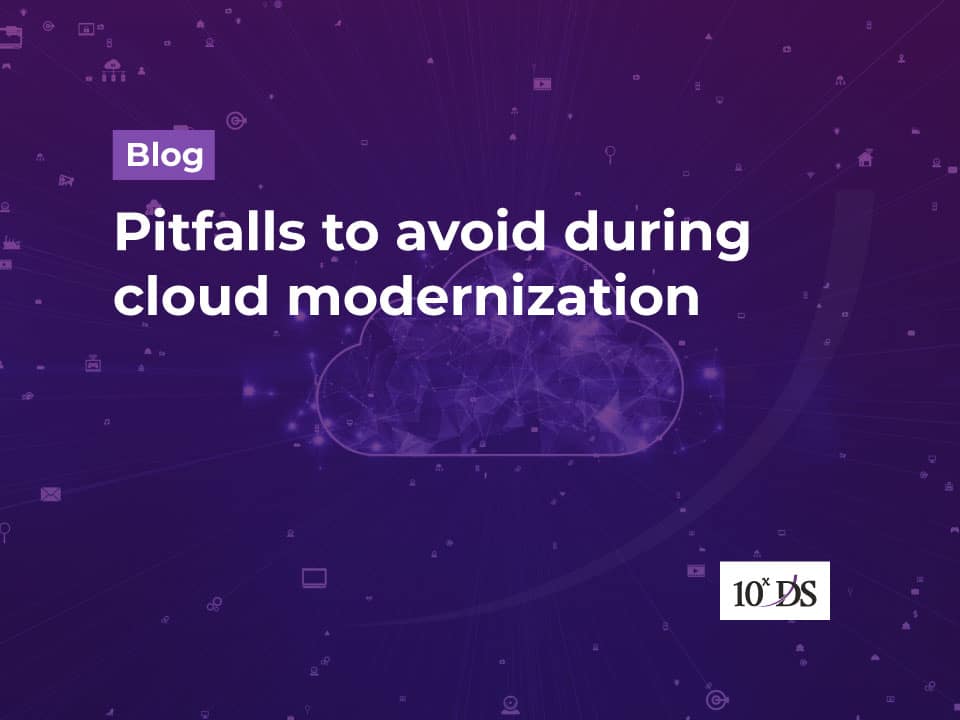
Pitfalls to avoid during cloud modernization
Delivery of computing services over the Internet (the cloud), rather than using local servers or personal devices, helped organisations access and use resources on demand without the need to build and maintain their own infrastructure. This can be more cost-effective and scalable than maintaining on-premises servers, and it can enable organisations to be more agile and responsive to changing business needs. There are three main types of cloud computing services:
- Infrastructure as a Service (IaaS): Provides access to fundamental computing resources such as virtual machines, storage, and networking.
- Platform as a Service (PaaS): A platform for developing, testing, and deploying applications without the need for underlying infrastructure maintenance.
- Software as a Service (SaaS): A subscription-based internet-based access to software applications.
A number of companies offer cloud computing services. These include public cloud providers like Amazon Web Services (AWS), Microsoft Azure, and Google Cloud, as well as private cloud providers that only serve one company.
Many organisations choose to modernise their technology with the cloud, which is called “cloud modernization.” This involved the process of updating the organization’s technology infrastructure and application architecture to take advantage of the benefits of the cloud. That is moving from on-premises servers to cloud-based infrastructure, refactoring applications to be more cloud-native, or adopting new cloud-based tools and services. Cloud modernization gives organisations improved scalability as it is easier to scale up or down as needed to meet changing workload demands. It also enables organisations to respond more quickly to changing business needs by helping to quickly deploy new applications and services. Pay-as-you-go pricing models offered by cloud providers are more cost-effective than maintaining on-premises servers. Many cloud providers offer advanced security measures to protect data and applications, which can be more difficult and costly to implement on-premises. Cloud-based applications and services can be accessed from anywhere with an internet connection, enabling organisations to reach a global audience more easily.
There are many companies that have successfully modernised their technology with the cloud and are reaping the benefits. Some examples include:
- Netflix: Netflix migrated its entire video streaming platform to the cloud in the late 2000s. This enabled the company to scale up and down as needed to meet changing demand and quickly roll out new features and services.
- Spotify: Spotify migrated its music streaming platform to the cloud in the 2010s. This enabled the company to scale up and down as needed and to quickly roll out new features and services.
- Capital One: Capital One migrated its core banking systems to the cloud in the 2010s. This made it possible for the company to improve the performance and reliability of its systems and cut costs.
- Airbnb: Airbnb migrated its entire platform to the cloud in the 2010s. This enabled the company to scale up and down as needed to meet changing demand and quickly roll out new features and services.
Even though it’s difficult to identify specific companies that have “failed” with cloud modernization, the success of a cloud migration project depends on a variety of factors and can be difficult to quantify. However, there are certainly examples of companies that have encountered challenges or difficulties during the cloud modernization process, especially government agencies around the world. These projects were reported to have encountered legal challenges, several delays, and cost overruns, and ultimately did not deliver the expected benefits. It’s important to note that every cloud modernization project is unique, and what may have been a challenging or unsuccessful project for one organisation may not necessarily be the case for another.
If any organisation is considering cloud modernization, it’s important to carefully assess needs and goals and to plan migration carefully to ensure a smooth transition. Of course, every organisation is different, and the decision to move to the cloud should be based on a careful assessment of the organization’s specific needs and goals.
Common challenges organisations may face when modernising with the cloud include:
- Complexity: Migrating to the cloud can be a complex process, especially for organisations with a large and varied technology stack. It can be hard to figure out how to move different types of workloads and applications to the cloud in the best way.
- Interoperability: Different cloud providers have different tools, services, and APIs, which can make it challenging to migrate between them or integrate with on-premises systems.
- Security and compliance: Organizations may be concerned about the security and compliance implications of moving sensitive data and workloads to the cloud. It’s important to carefully compare the security measures that different cloud providers offer and to put in place the right controls to keep sensitive data safe.
- Cost: In some cases, the cloud can save you money, but it’s important to compare the costs of different cloud providers and services to make sure they fit your budget.
- Culture and change management: Migrating to the cloud can require significant changes to an organization’s technology stack and the way it does business. To make sure the change goes smoothly, it’s important to carefully manage this process and talk to everyone involved.
However, there are several strategies that organisations can use to overcome the challenges of cloud modernization. Some approaches include:
1. Careful planning
It’s important to carefully assess your organization’s needs and goals and plan your cloud migration accordingly. This can help you identify potential challenges and develop strategies to address them. Migrating to the cloud can be a complex process, especially for organisations with a large and varied technology stack. It’s important to accurately assess the scope of the migration and to allocate sufficient resources to ensure its success. Without a clear plan, it can be difficult to ensure a smooth transition and realise the full benefits of the cloud.
2. Adopting a phased approach
Rather than trying to migrate everything to the cloud at once, it can be helpful to adopt a phased approach and prioritise the most important or time-sensitive workloads.
3. Careful evaluation of security and compliance
Security and compliance are critical considerations when moving sensitive data and workloads to the cloud. It’s important to carefully compare the security measures that different cloud providers offer and to put in place the right controls to keep sensitive data safe.
4. Leveraging cloud-based tools and services
There are many tools and services available that can help organisations migrate to the cloud and manage their cloud environments more effectively. These can include migration tools, monitoring and management platforms, and automation tools.
5. Estimating costs and returns
The cloud can sometimes save you money, but it’s important to compare the costs of different cloud providers and services to make sure they fit your budget.
6. Building a strong team
Building a strong team with the right skills and expertise can be key to a successful cloud migration. This can be done by hiring or training staff in-house or by teaming up with cloud service providers or consulting firms.
7. Communicating with stakeholders
It’s important to communicate clearly with all stakeholders throughout the cloud migration process to ensure that everyone is aware of the changes and the benefits they will bring. This can help smooth the transition and build support for the project.
Conclusion
The adoption of cloud computing has not been without challenges, however, some organisations have encountered difficulties during the migration process or have struggled to effectively manage their cloud environments. Despite these challenges, the overall trend has been towards increased adoption of the cloud in organizations.
Talk to our experts to learn more!

